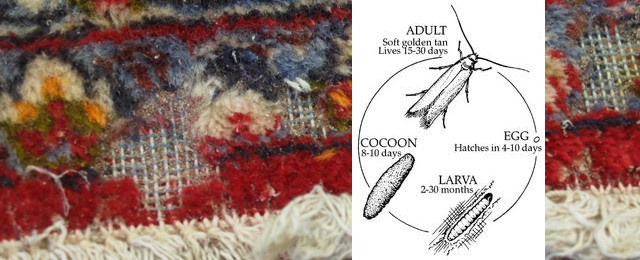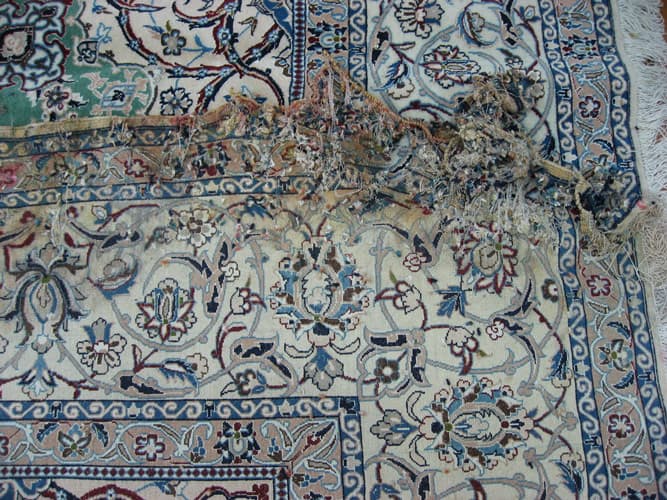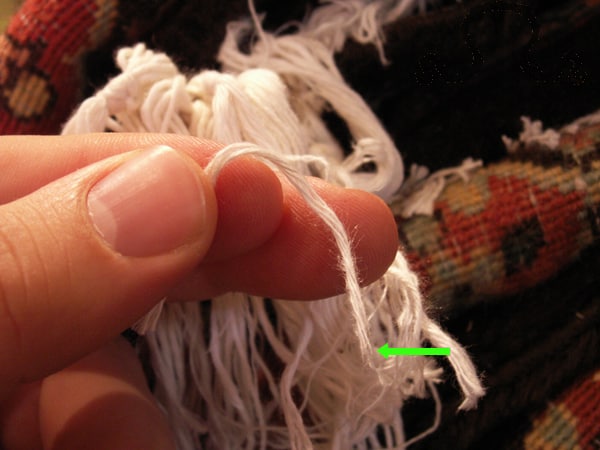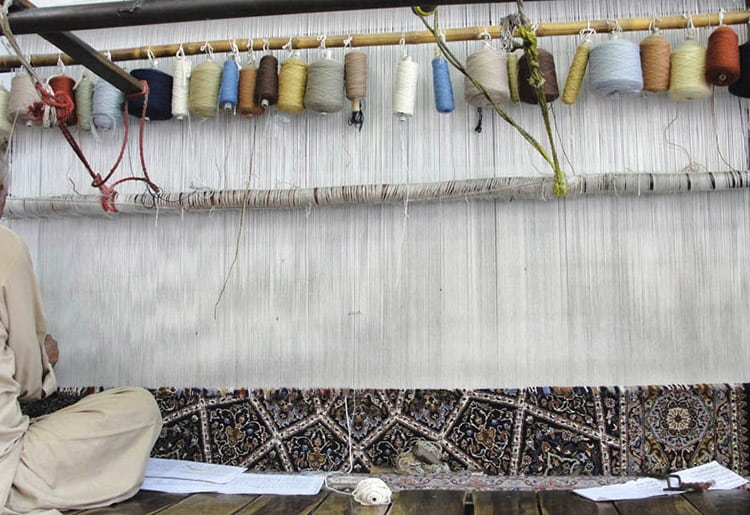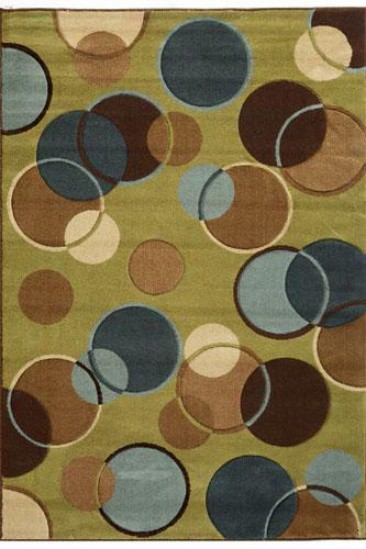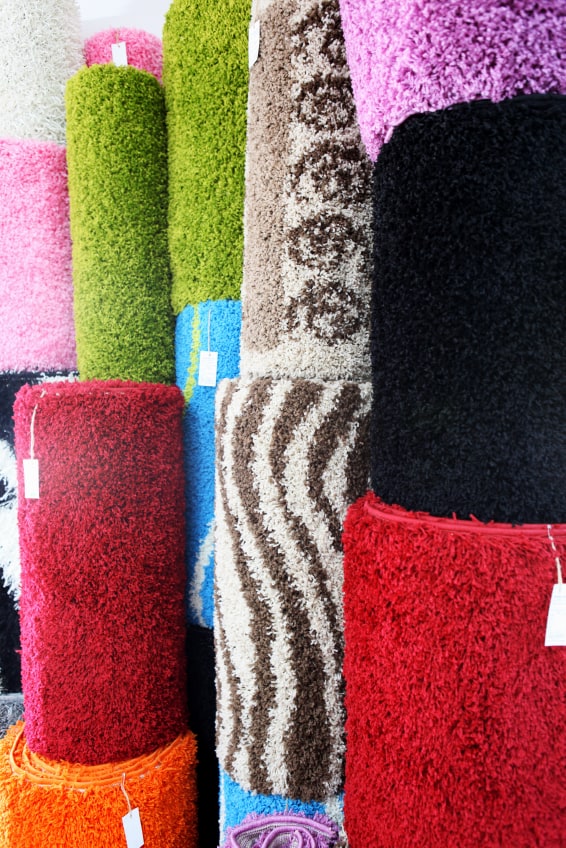Besides being utterly beautiful, genuine hand-knotted Oriental and Persian rugs are extra durable and can last in time, provided you know how to take care of them to protect them from premature wear and damage. Some of the most common problems Oriental rug owners face include:
1. moth damage
2. water damage
3. pet stains
4. dog chews
5. vacuum cleaner damage
6. cat scratching
7. chemical damage
8. uneven wear.
Here, you will find the most FAQs regarding Oriental rug care.
1. Moth Damage
Image: fredremmers
Clothes moths can fly. However, they don’t eat your rugs. What causes severe damage is when the female moth lay their eggs (hundreds each), which hatch into larvae and consume silk fibers, wool, feather, and fur. Their ideal environment where they thrive in is anywhere dark and quiet. The parts of the rug that receive the less foot traffic and are less vacuumed is a moth paradise. How to know if your rug is being infested by moths? You will notice sand-like debris along with a coweb-like veil in the damaged area. It should be noted that an infestation usually spreads from (or to) sweaters stored in a drawer or furs or woolens hanging in a closet and is not that difficult to repair, although it will probably cost much if large areas of the rug need to be reweaved.
Now, to be able to identify the presence of moths, here are some signs to help you (except for the obvious webs):
- Bare spots in the pile – Larvae moths show clear preferences towards the taste of a specific color yarn over another. Bare spots can be tastier, especially if they have the particular color moths love to consume.
- Cocoons – Cylinders of about 1/8” in diameter and approx. ½ an inch long (usually the same color as the pile of the rug) are a strong indication of moth activity. Know that larvae have the ability to camouflage their cocoon to blend in with the color of the surrounding wool. Just after hatching, moth larvae about 3/8” long can be seen in the pile, right before they construct their cocoons. This is when they eat the wool.
- Flying moths – Clothing moth is less than 3/8” long and is either soft brown or silver tan in color. It flies slowly, and if you attempt to catch it with your hands when flying, it will fold its wing and just drop to the floor.
- Loose or Broken Piles – It means that the larvae chew through the bindings or yarn overcastings.
- Sand-like particles – This is the excretion of the larvae and is usually granular in look and brown or tan in color. You can spot them down in the rug’s pile.
Here is all you need to know about bugs and moth.
How to prevent moth damage
Vacuum your rug every week, if that is possible (the entire face). The back side of the rug should also be vacuumed several times a year (don’t forget to vacuum the floor underneath and pad, too).
If you cannot handle the rug because of its size, flip its ends over and vacuum at least a couple of feet in along the borders of its back side (remember to do the same with the floor and pad, as well).
If you are using moth crystals, flakes, or balls (i.e. naphthalene), you are just wasting your time. They are ineffective in moth control when it comes to rugs. These materials don’t exterminate moth larvae and act rather as a mild repellent to them. Plus, the odor of naphthalene is not something anyone like smelling and is difficult to remove from the rug. The same goes to cedar scent that does absolutely nothing in moth damage prevention.
Spray any areas that you cannot easily reach with the vacuum cleaner (i.e. under furniture) with an insecticide made for household purposes (choose a non-staining one). The vast majority of these products contain active ingredients extracted from the chrysanthemums’ flower heads (pyrethrins), which are poisonous to many insects. However, after you apply them, they break down fast and are considered safe for home use.
Important Note: When you choose and apply an insecticide, always select a product that was designed for the particular use you want it. Needless to say, follow application directions closely and make sure you store and dispose of it carefully.
Note: Beetle larvae damage is similar to moth damage in appearance but not as severe and messy as moth damage. Whatever strategy you choose to treat or prevent moth damage will also be effective against rug beetles, too.
2. Water Damage
Most varieties of Persian and Oriental rugs have a wool pile. Nevertheless, many come with cotton weft and warp (the foundation where knots are tied upon to create the pile), which can be seriously weakened and, in some cases, even rotted, if the rug is wetted several times (e.g. from potted plants sitting on the rug that are watered regularly and leak, leaving the rug permanently damp) and is not dried properly. It usually doesn’t take more than two weeks for the foundation to become weakened to the point chucks can be relatively easily torn from the affected area with bare hands. So, if you are using planters, try to place them on a caster-based support or a slim legged stool. That way, you will be able to see under the pot (always check the rug after every watering to see if it is completely dry).
Water damage can also occur on rugs that are placed below grade level, such as a basement (imagine the damage if the basement floods). Equally damaging is to place a rug on a damp floor (i.e. cement floors). You may not feel the floor wet to the touch, but there still could be enough moisture to provide a cozy environment for microorganisms to thrive in the material of the weft and the warp and lessen the strength of the carpet’s foundation. If this is your case, your rug feels stiff (sometimes too stiff) to roll or manipulate. Listen carefully every time you fold or crease the rug. You will most likely be able to hear popping noises coming from the back of the carpet. This is the sound of weft and warp fibers breaking.
3. Pet Stains
We have put together a handy guide with helpful tips and advice regarding pet stains on rugs and ways to remove them.
4. Dog Chews
Puppies just love to chew everything they can get their growing teeth into. The best way to prevent that from happening is to keep the pup away from the rug. You could also sprinkle moth flakes (about an ounce will do) along the edges of the rug (under it). This should help the frisky furry friend keep his distance from the carpet!
5. Vacuum Cleaner Damage
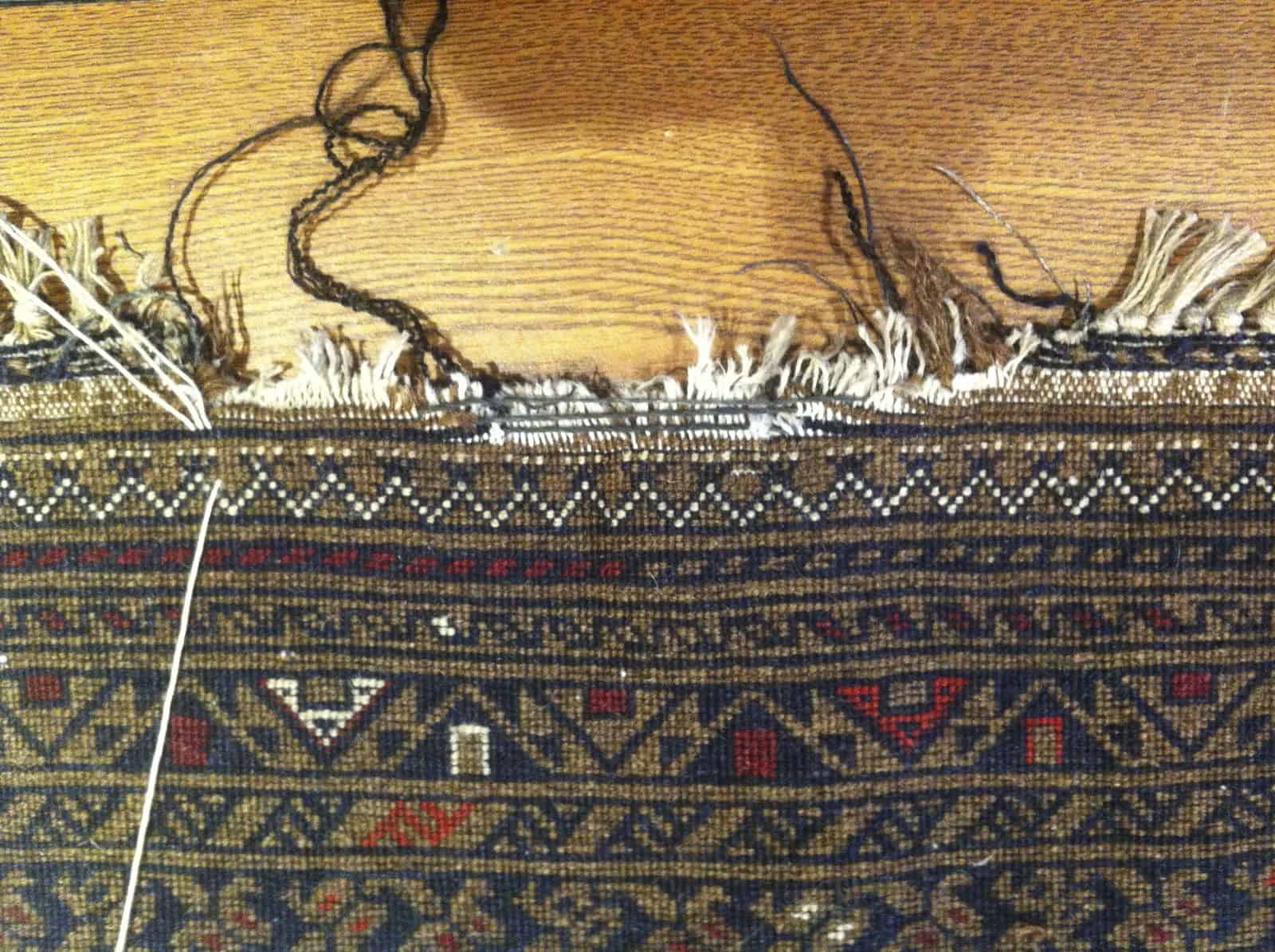
Most of the times, vacuuming an Oriental rug helps keep it clean. Its surface is dirt-free, and dirt is also prevented from being filtered down into the pile, where it does not only accumulate but also speed up wear damage. However, you should be careful when using a vacuum cleaner. If it is equipped with a beater bar or a power brush, you will probably cause a raking effect on rug’s top layer because this equipment is mostly designed to do an excellent job on machine-made rugs. What can you do if your vacuum cleaner has such a power brush? Use it occasionally and not too strenuously on your Oriental or Persian carpet. For routine cleaning, you can always use the plain nozzle, especially if you are about to vacuum fringes, which require delicate use. Otherwise, the brush will shred them and cause swift wear. Also, you run the risk of having them caught (and chewed up) by the brush’s rotating mechanism.
6. Cat scratchings
Cats love sharpening their claws, and they will do so on whatever they can get a hold of, including your precious Oriental rug and severely damage it. If your cat is not declawed, again the best prevention is to keep the cat away from the rug and control its activities. Some cat owners also use a squirt gun ans skirt their cat every time she starts scratching the carpet.
7. Chemical damage
Image: rugrag
Some rug cleaners like to bleach the fringe of Oriental rugs before they return it to the customer. The concept behind that activity is that if the fringe looks clean and neat, the whole rug looks more beautiful and cleaner. The bad news is that over time, bleaches with chlorine as their active ingredients weaken the natural fiber, and it is not uncommon to see fringed so weakened that you can actually tear away a tug on the fringe small bits. This is what we call a dead fringe, and it is never a pretty sight. Now, if you want your fringe to be snowy white, try using a dilute bleach solution. After the application, make sure you rinse the fringe meticulously. Here is more information about what to do if your fringe cannot be cleaned.
Note: The sun’s ultraviolet rays can also cause damage to your Persian rug, which will fade over time if exposed to the sun (placed in sunny areas) for a long time. Block some of the direct sunlight by using sheer drapes.
8. Uneven wear
Don’t place the rug on uneven floor (the rug wears faster where the floor is raised) and try to turn it end-for-end at least once or twice a year to even out any color change and wear.
You may also want to have a look at our article about Carpet cleaning hacks that will make your life easier!

